How to make Italian meringue (and improve your sorbets)
Only about a generation ago, high-class pastry chefs and master ice cream makers would improve their sorbets by adding Italian meringue. These days, this technique is not so commonly used. But making and using Italian meringue remains a good idea, and is luckily something which can be (relatively) easily learned. Myself, I was fortunate to learn from a pro, and I will happily pass on the know-how, in 7 detailed steps.
Why Italian meringue is so interesting for sorbet-makers
Sorbets tend to be best enjoyed fresh. This is partly because they tend to deteriorate quickly if kept in the freezer for any longer time. And this, in turn, is mainly because they begin to lose air. But there are ways to help a sorbet retain a nice consistency – one major way uses egg whites. These days, most chefs probably simply whip up a raw egg white and add it to the sorbet base. But the supreme, old-fashioned way would be to cook the egg whites first … into Italian meringue.
Structurally speaking, Italian meringue works much like a whipped-up egg white: A whipped up egg white will capture and retain a lot of air. But the meringue, being much more stable, will retain the air much, much better. The meringue, once added to the sorbet, will disperse totally – ensuring a smooth, scoopable consistency, increased durability in the freezer and, arguably, an extra dimension to the whole tasting experience. If not ‘overdosed’, it should not alter the basic flavour character of the sorbet either (it will, however, pale the colour of the sorbet somewhat). Sounds great already, does it not?
There is also the health aspect: Unless pasteurised, raw eggs can contain Salmonella and should best be avoided, at least by toddlers, pregnant women and the elderly. This risk of Salmonella may be relatively small, and it varies between countries and regions. But still – the risk is there.
However – if prepared properly – the egg whites in Italian meringue will be sufficiently heated to take care of these health concerns, and should be safe to use and eat.
UPDATE: For an egg-free/easier alternative to Italian meringue – make aquafaba meringue: it may not be as classic but provides the same advantages!
Italian meringue for dummies – in 7 detailed steps
With so much apparently going for it, I just had to try Italian meringue. But how?
When you read about it, the basic steps for creating Italian meringue seem straightforward: prepare a hot sugar syrup and whip it into softly whipped egg whites till stiff. Since the sugar syrup is hot, the egg whites will be soft-cooked and you will end up with a kind of (soft) meringue. Most recipes also listed only three ingredients: water, sugar and egg whites (and some lemon juice). How hard could that be?
The trouble was that while some recipes were about as short as that, others hinted at difficulties, issues of timely co-ordination, and various temperatures to keep track of. And since I never had seen any Italian meringue before, how would I know what it should look like? I started to get the feeling that this process perhaps was not quite so uncomplicated after all.
To prevent otherwise anticipated high levels of personal frustration and the spoiling of numerous eggs, I concluded that the best way for me to learn would be to watch someone who already knew how to do it in action. Luckily, my good friend Peter Englund – experienced professional chef, former restaurateur and generally fond of ice creams – graciously offered to show me the ropes!
Before outlining the detailed steps, let me recall that the reason for being fussy with the temperatures is because of the health concerns: Ultimately, you should bring the sugar syrup up to the so-called hard-ball stage (121°C /250°F ) before it is being added to the (whipped) egg whites. In case you do not master the candy maker’s/pastry chef’s techniques to estimate the sugar-temperature brackets, I also strongly recommend that you use a sugar thermometer (I did!). Again, if the sugar syrup is not heated to the required heights, the egg whites in the resulting meringue will not have been cooked enough to be considered ‘food safe’.
A word about the amount of meringue you will get
Since it is quite difficult to work with too small volumes in the kitchen, the recipe below will make enough Italian meringue for about 4 batches of sorbet. But if you end up with too much left, you could store the Italian meringue in the freezer for a while, and use it later. Or turn on the oven (110° C/230° F for at least 1 hour should do it), and make some ‘ordinary meringues’.
Step 1 – Set up the equipment, prepare for whisking the egg whites
Since the recipe will require A LOT of whisking, it is strongly recommended to use a kitchen assistant/food processor or the like (with a whisk). It is also highly recommended that you use a sugar thermometer to be able to judge the temperatures of the sugar syrup.
Begin by putting the egg whites in the whisking bowl of the kitchen assistant. But do not begin whisking just yet.
Step 2 – Prepare hot sugar syrup
In a sauce pan, combine water, sugar and the lemon juice and begin cooking a simple sugar syrup. As you will notice, the proportion of water is markedly smaller than in ordinary “sugar syrup for sorbets”-recipes. And this quantity will even diminsh further once you begin boiling the sugar syrup. But since the purpose of the meringue is not to provide additional liquid but more stability, this is exactly as it should be.
Bring the simple sugar syrup to the boil – and keep it boiling until the syrup has reached a temperature of 110° C /230° F (the so-called “Thread-stage”).
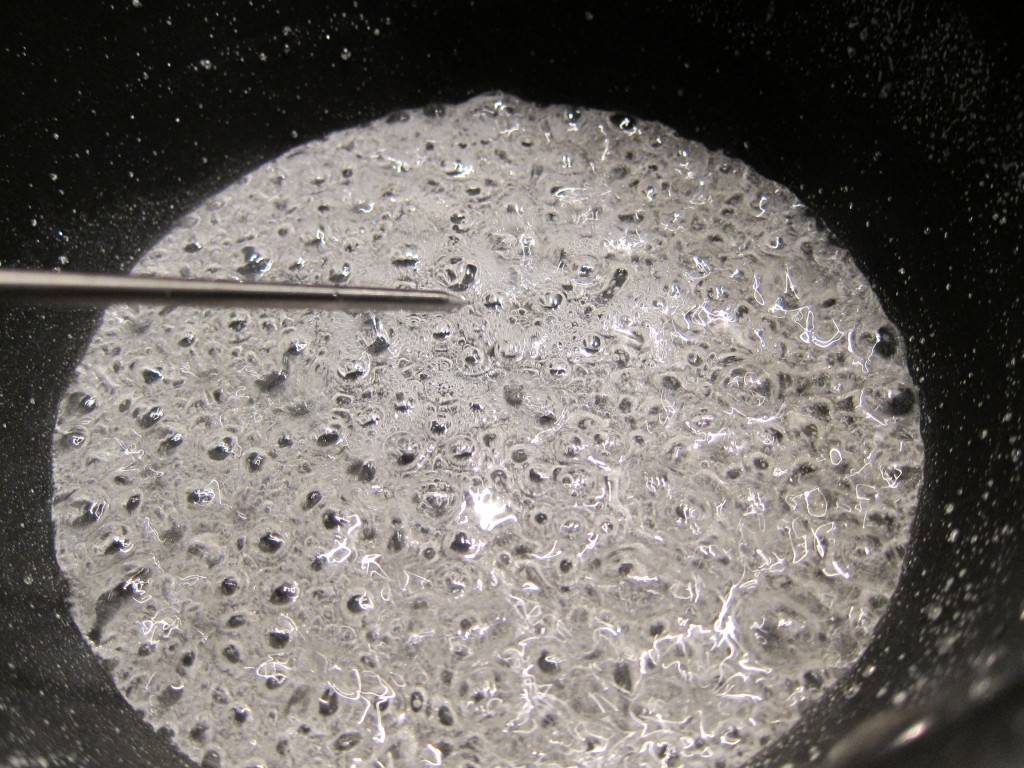
Building up heat: Once the sugar syrup reaches 110° C /230° F (the so-called “Thread-stage”), it is time to begin whisking the egg whites on the side
Step 3 – Start whisking the egg whites
Now, flip the switch on your kitchen assistant and start whisking the egg whites! While continuing to boil the sugar syrup towards 122° C/ 251° F, whisk the egg whites (adding a tablespoon of sugar to them) at high speed.
Let the kitchen assistant continue to whip the egg whites to foamy, soft peaks, while you return to the boiling of the sugar syrup (you will return to the egg whites once the sugar syrup is hot enough to be added in).
Step 4 – Bring the sugar syrup to 122° C / 251° F (the so-called Hard-ball stage)
Once the sugar syrup has reached this temperature it is hot enough to make “health safe” meringue out of the whipped egg whites. No time to lose, since you want to use the syrup while it remains at this high temperature! Immediately jump to the next step!
Step 5 – Reduce the whisking speed and carefully drizzle the hot sugar syrup into the egg whites being whipped
By now, the egg whites should have been well whipped into foamy, soft peaks.
Continue whisking the egg whites but reduce the speed to medium. Then, in a thin, steady stream, carefully drizzle in all of the hot sugar syrup.
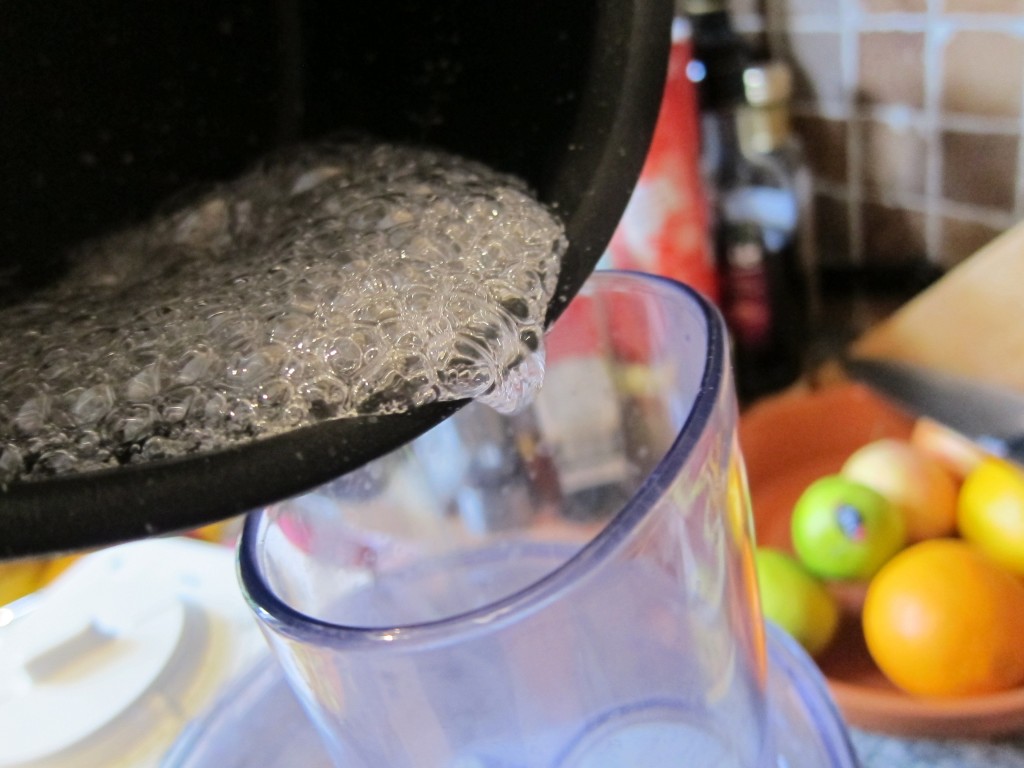
Carefully drizzle in the hot sugar syrup while continuously whisking the egg whites (at a slower speed now, however).
Step 6 – With all syrup added, turn up the whisking speed and continue whisking for about 10 more minutes
Once all sugar syrup has been added, turn up the whisking speed again and leave the machine to do its work for about ten more minutes. By now, the meringue should be ready and – while still warm to the touch – should also have cooled down somewhat.
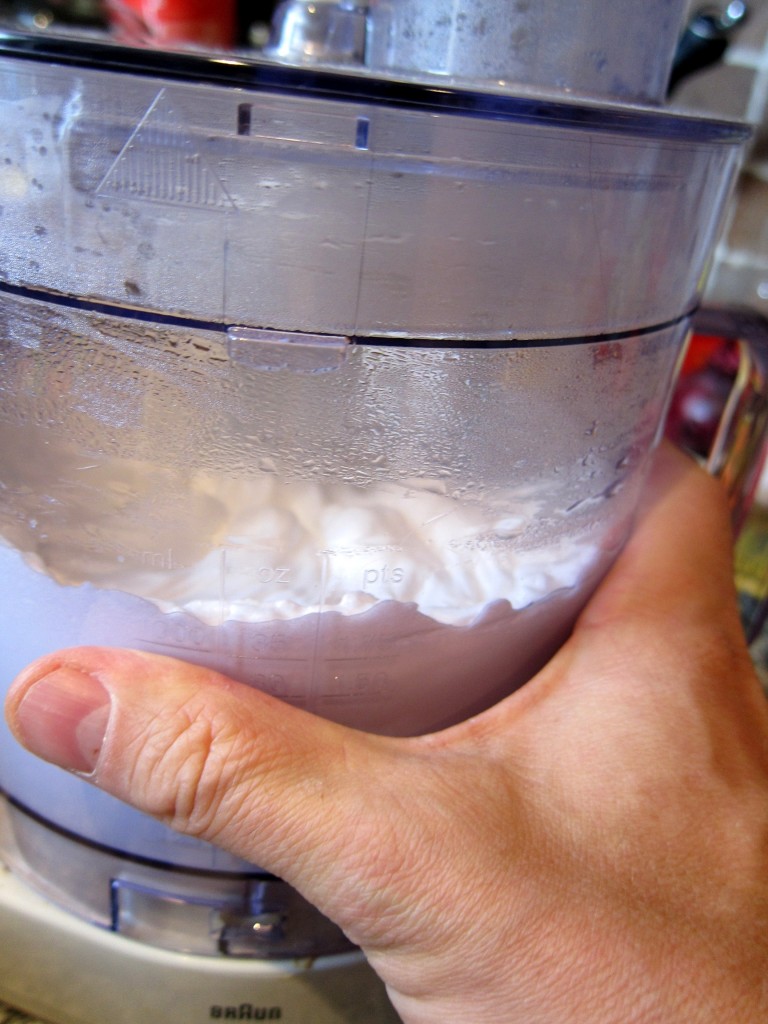
Continue to whisk until the meringue has begun to cool down, about 10-15 minutes or so. It will still feel warm to the touch, however.
Step 7 – Enjoy your Italian meringue!
Your meringue should now be ready, and look something like this:
If you have any doubts about whether it has been whisked sufficiently, you could carry out the classic “meringue-test” (demonstrated by Peter below).

The classic way to test meringue: if the meringue stays in place and does not fall down on your head, it is ready.
Congratulations – You have now created Italian meringue!
Using the Italian meringue in sorbets
Italian meringue can basically be used together with any sorbet, and application is straightforward: When the sorbet has been churned almost to the finish, blend in an amount of meringue (roughly) representing 1 egg white.
Continue churning a bit, or simply put the sorbet in a freezer-safe container right away, cover with plastic film and a lid and store in the freezer.
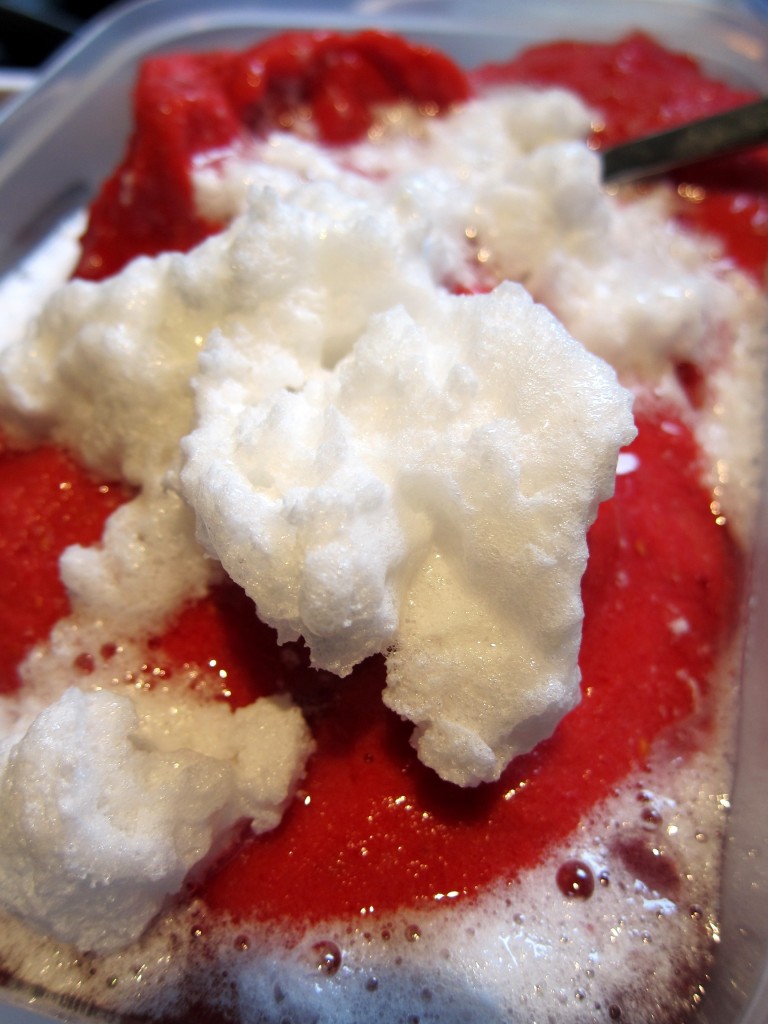
The Italian meringue about to be blended into the sorbet base. Soon, the meringue will only be noticable by the way it pales the colour of the sorbet
How much Italian meringue should be added?
The typical amount to be added should basically reflect 1 egg white’s worth of meringue.
Using this recipe, that would mean 1/4 of the meringue created (or about 50 grams). Some like to add even more (moving towards 2 egg whites’ worth). While this obviously is a matter for personal taste, just remember that it is easier to add more than to reduce what has once been added …
In order not to turn the basic sorbet flavour into something else, it is important not to add too much of meringue. If too much is added, you will eventually end up with a sorbet that begins to shift in character, away from the basic flavour used. Ultimately, you will end up with a spoom – a particular type of sorbet, interesting in its own right but … well, different (UPDATE: read more about spooms in this post!)
Reduce the sugar in your sorbet to compensate for the sugar added by the meringue
Since the meringue you add contains sugar, you might want to reduce the sugar used for making the sorbet base accordingly. If you go by the recipe here, and the suggested amount of meringue to be added (the equivalent of 1 egg white’s worth), this would mean that the sugar you normally would use for your base sorbet should be reduced with about 40 ml/ 0.16 cup.
So, to summarise: Prepare a sorbet base of your choice but reduce the sugar with about as much sugar as will be added through the meringue later. Then (for a typical base of about 600-700 ml / 2 1/2-3 cups) add about 50 grams of Italian meringue (= 1/4 of your total acquired final meringue) and whisk into the sorbet.
Storing your Italian meringue
If not to be used immediately, the Italian meringue could luckily be stored in the freezer for later use! It will also last at least a couple of days in the refrigerator, but may begin to “weep” so freezing it is probably to be preferred.
- simple sugar syrup, made up of 60 ml water (1/4 cup) and 150 ml sugar (about 0.6 cup)
- juice of ½ lemon (about 1 teaspoon)
- 4 egg whites
- 1 tablespoon sugar [for the egg whites, not the sugar syrup]
- Place the egg whites in a food processor equipped with a whisk (or the equivalent automated help, unless you prefer to do a LOT of whisking by hand ...) but do not begin any whisking for now.
- Instead, cook the simple sugar syrup - mixing the sugar, water and the lemon juice - until all the sugar has dissolved and the liquid has reached a temperature of 110° C / 230°F (the so-called Thread-stage).
- Now, while continuing to boil the sugar syrup, turn on the food processor and begin whisking the egg whites at high speed, adding a tablespoon of sugar to them.
- When the sugar syrup has reached 122° C / 251° F (the so-called Hard-ball stage), it is hot enough to be added to the whipped egg whites (these should have been well whipped into the 'resembles foamy cream stage' by now). Turn down the whisking speed to at least medium and carefully begin drizzling in the hot sugar syrup into the whipped egg whites.
- When all the sugar syrup has been added, turn up the whisking speed to maximum again and leave for about 10-15 minutes until the meringue has cooled down somewhat and is ready.
- The ready-to-use meringue should resemble firmly whipped cream.
- # Using the meringue in sorbets:
- Prepare a sorbet base of your choice but reduce the sugar with about as much sugar as will be added through the meringue later (= about 40 ml/ 0.16 cup). Then (for a typical base of about 600-700 ml / 2½-3 cups) add about 50 grams of Italian meringue (= ¼ of your total acquired final meringue) and whisk into the sorbet.
- Continue churning the sorbet for a while and/or put the sorbet in a freezer-safe container, cover with plastic film and a lid and store in the freezer.
- The Italian meringue will generally improve consistency and smoothness through the stability and retained air it provides, also ensuring improved scoopability even after many hours in the freezer.
- If not used immediately, the Italian meringue could be stored in the freezer for later use (pack it like the sorbet!)
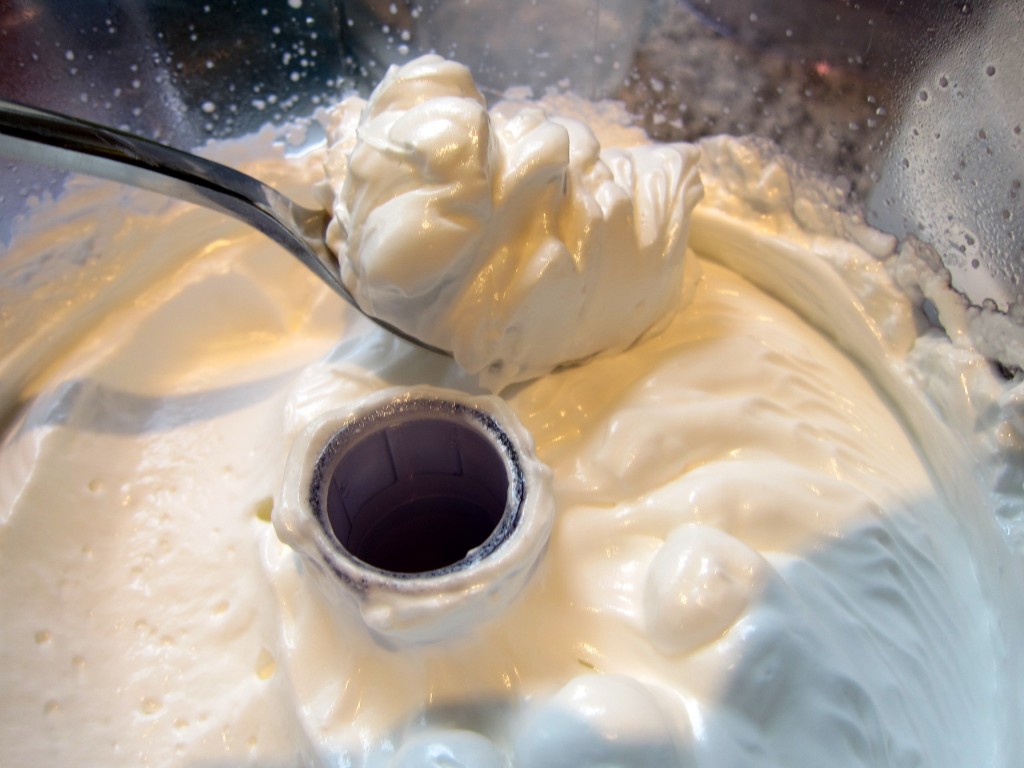

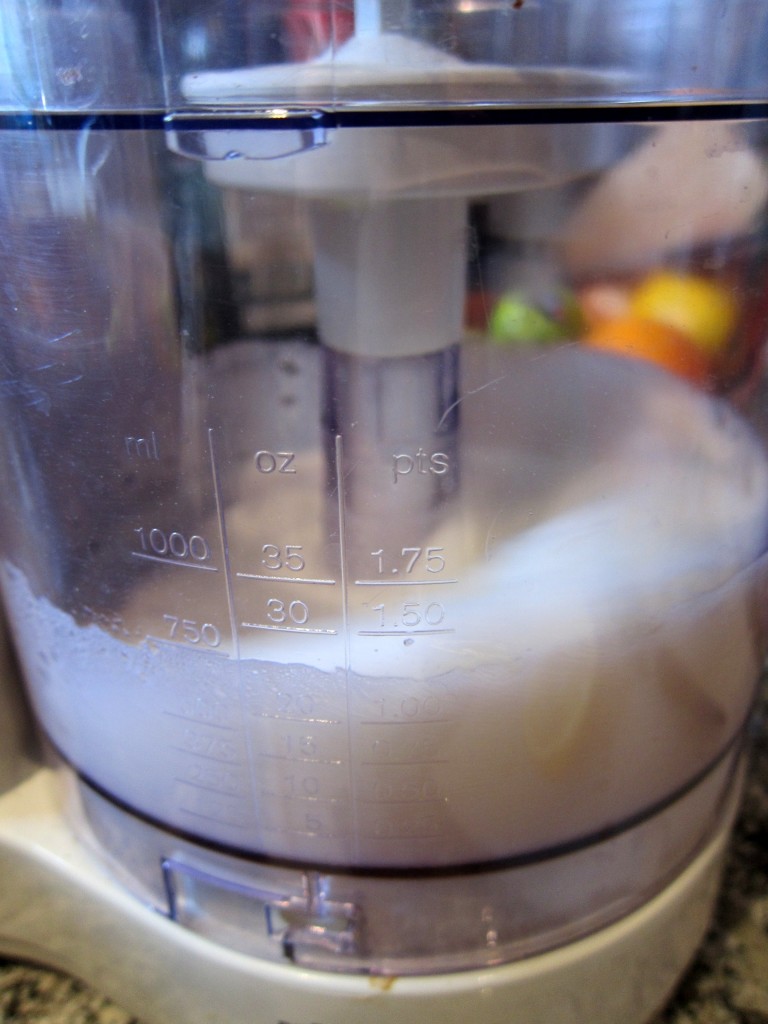
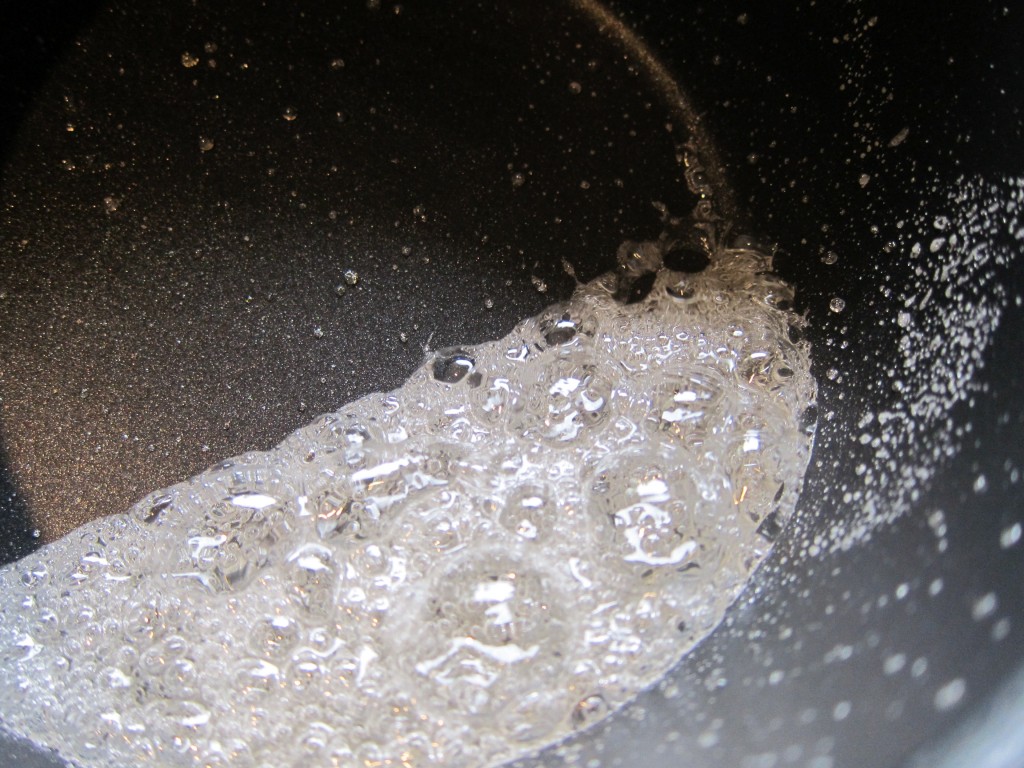
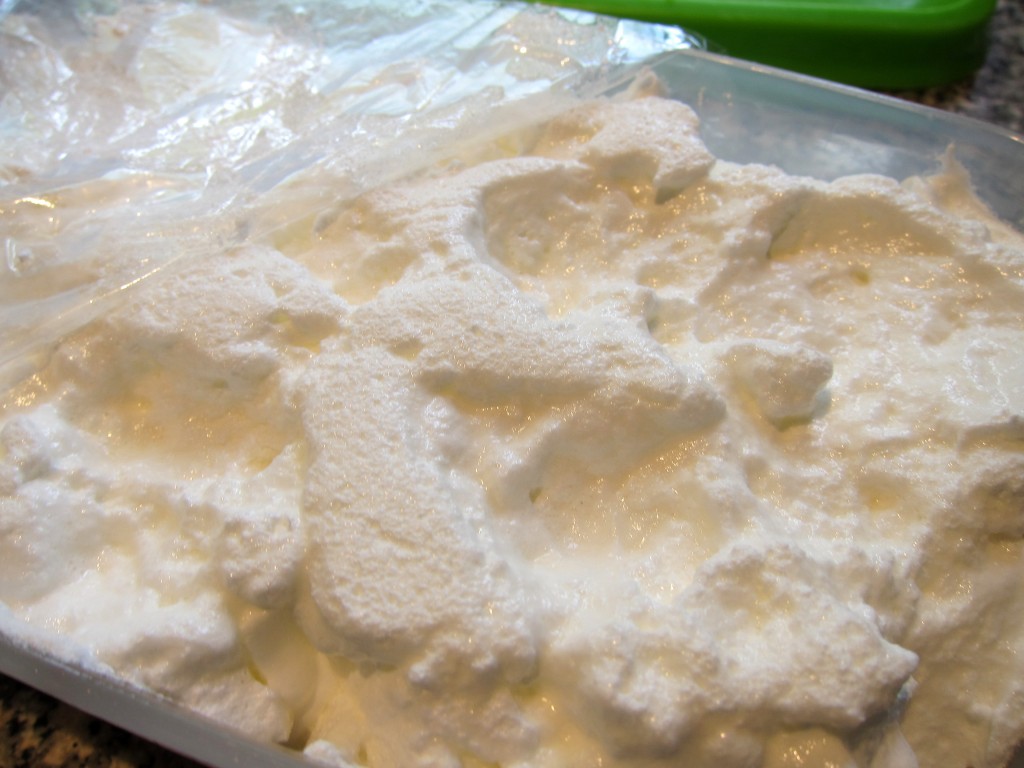
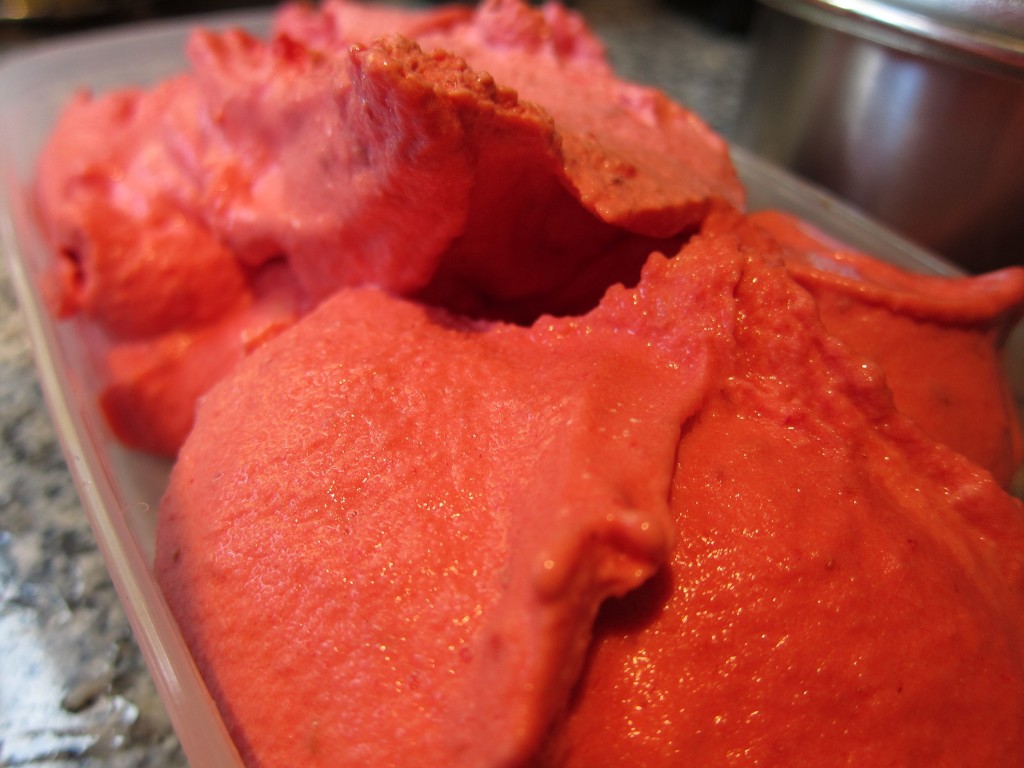
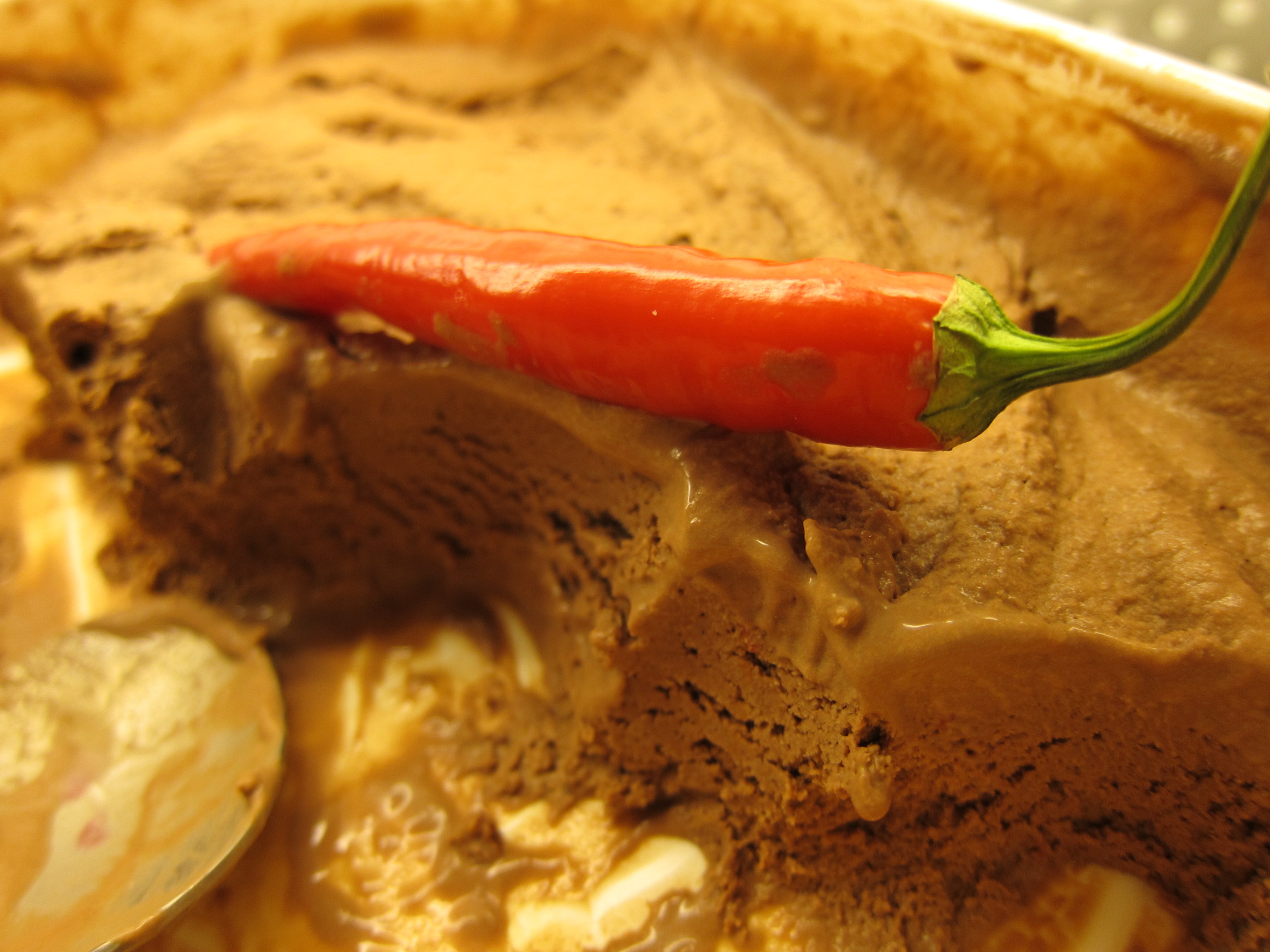

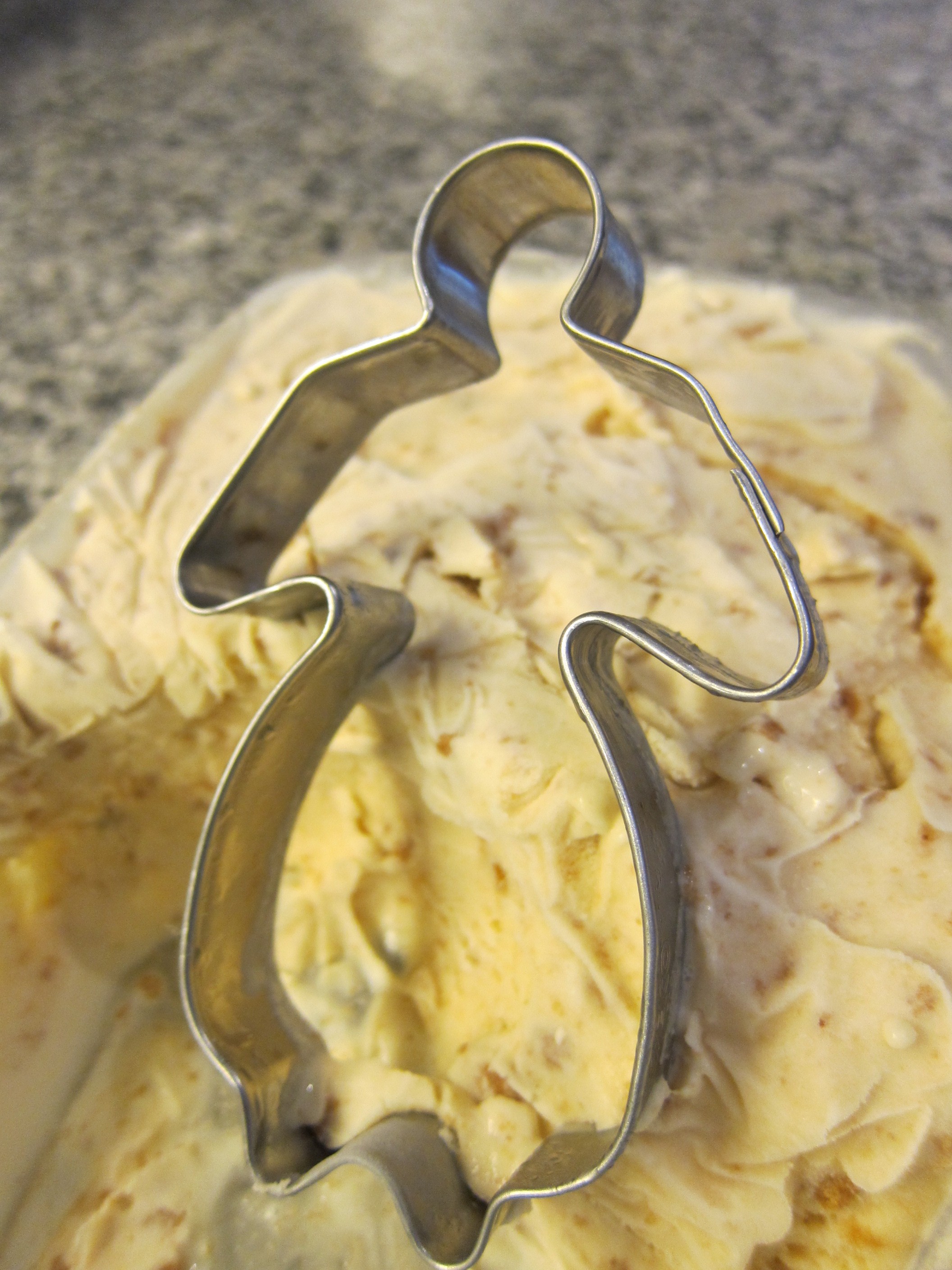


Very helpful post. Exactly what I was looking for to solve the raw egg white issue for my sorbet!How long will the frozen meringue keep in the freezer and can it be used in other recipes like chiffon cakes? I’m not sure how to use frozen meringue. Thanks in advance.
Hi Soh,
If stored in a dry and well-covered Way, the meringue will keep for quite a long time in the freezer (weeks rather than days). Eventually, however, you will notice that it starts to “shrink” (a consequence of the trapped air leaving – a slow but inevitable process, similar to what happens to ice creams left for too long in the freezer).
Since I only use mine for ice cream-purposes, I can’t vouch for the other uses, but it would seem to me that you shuld be able to use it also in cakes etc.
Hi I use italian meringue for great texture mousses. Example: lemon mousse
300 ml lemon juice + 50 gr sugar , 12 gr gelatin leaves ( or equivalent powdered gelatin), 600 gr italian meringue ( made with 180 gr egg white (3 medium egg whites) and 360 gr sugar. 500ml whipping cream, whipped. Dissolve softened gelatin in half or less of the lemon juice, heated with 50 gr sugar.
Works divinely with: lime, orange, tangerine, mandarin. Haven’t tried grapefruit.
Meringue can also be used as a base for a light chocolate mousse or berry / fruit mousse.
Mousse recipe from Michel Roux
Apologies for everything being in grams! i am Italian
Hi Francesca, and thanks for the mousse contribution – clearly, one can have a lot of fun with Italian meringue 🙂
Thank you so much — i’ve just tried your recipe for the italian meringue. It took longer than 10 mins to get it stiffen, maybe it’s because i used a hand-held mixer. Thanks for sharing.
Thank you very much for your detailed instruction. This solved the raw egg white problem beautifully. I’m working with several tropical fruit home made sorbet. Today I made coconut milk with custard apple. With and without your meringue was significantly different. Thanks again.
Dear Torroong,
You’re welcome, and best of luck with your meringue-sorbet creations 🙂
Thanks anders. Another great post. I bought an ice cream maker yesterday and I’ve found your website to be absolutely superb. So helpful!
I’m about to make an italian meringue based earl grey and cucumber sorbet to accompany a smoked salmon starter. Do you think adding a little black pepper would have a detrimental effect on the consistency (maybe act ad a nucleation point for ice crystals)?
Dear Jonny,
Glad to hear you find the website helpful 🙂
And to your question, no – I would be very surprised if a little black pepper would impact negatively on the consistency (with the flavours you have in mind, I would rather believe that it could add to the final attraction).
Thank you for your detail step and it’s very useful for me.
I got a little confuse about the step of making sorbet by machine.
Should I mix the fruit juice & meringue together before pasteurization step?
Thank again for everything.
Dear lan Lin,
You may find this post helpful: There, you will find a step-by-step description on how to actually make a sorbet with Italian meringue.
As you will see there, the process of making the Italian meringue is separate from the one where you prepare the actual sorbet – prepare the meringue first. Then, make the sorbet (in which you then add the meringue)!
Hi, thanks for your sharing. Could I reduce the amount of sugar for the Italian Meringue for about 1/2?
Calvin,
You could certainly try – even if the meringue should be able to “hold together”, however, the result will not be as tasty. Whether the trade-off is worth it is a question best answered by yourself and your taste buds 🙂
I followed your recipe and it worked out great. I now have 3 portions of italian meringue in my freezer. When I make my next sorbet do I need to re-whip the italian meringue? or just de-frost and add it to the churning sorbet?
Leah,
Glad to hear it worked out so well for you! Next time, you only need to defrost the meringue a little and add it to the churning sorbet (no need to do any re-whipping).
When i make italian meringue I add a pinch of cream of tartar instead of lemon juice. Will this affect the sorbet? Also, can I add limoncello to the meringue and at what stage would I add it?
Hi Frances,
Yes, you can use cream of tartar (or some white vinegar) instead of lemon juice to stabilise the meringue: it should make no difference to the sorbet.
I have not tried adding limoncello (or any other alcohols) directly to meringue myself, but would guess that it could be problematic: the added liquid would likely
thin out, and possibly even destabilise, the meringue. That said, adding limoncello to a sorbet made with Italian meringue is a different matter – just be careful not to overdose so it will freeze properly: when it comes to frozen desserts with alcohol, less is usually better than more 😉
Hi Anders,I wonder if you could help me as a boy in Scotland we had a local Italian ice cream seller named IZZI who sold gold medal winning ice cream Iam sure his ice cream contained egg whites .Instead of making a sorbet could I add cream to the recipe to make ice cream?
Thank you Arthur
Hi Arthur,
Interesting – many ice cream makers tend to use only egg yolks in ice cream, purportedly because egg whites add too much liquid compared to the “binding” qualities they bring.
That said, you can certainly try to include Italian meringue also in an ice cream recipe – even though the experience will be different, I think it could be very tasty. And who knows? You may even crack the secret of IZZI’s ice cream while experimenting. Best of luck!
Thanks Anders I have experimented with egg whites and a meringue base almost there.
When I lived in Florence, my favorite gelato was “meringue”, and it was creamy vanilla, sort of like a semifreddo, with bits of almost crunchy meringue scattered throughout. I have an ice cream maker – do you think it would work to just add bits of traditional broken up meringues to the vanilla mixture just at the end? I’m dying to try it. Also, a famous bakery/ice cream shop in Torino was well known for it’s rather large serving of a crisp meringue slathered in lightly sweetened whipped cream. Quite sweet but everyone loved it. I’ve served it here to Americans here in NY, and the unvarying response is, “Mmm delicious, but don’t you think a little chocolate sauce would make it better?” NO, NO!! is the answer. It’s the purity and whiteness of it that is so special; it is not am American sundae!
Hi Laurel,
Thanks for sharing – they know how to make good gelato in Florence, and I share your enthusiasm for “re-creating” favourite ice creams I come across 🙂 !
The short answer to your question is “yes” – you can certainly blend in some broken up meringue (of the stiff type!) to your vanilla base.
I have not (yet) made any “meringue-only” ice cream, but I did exactly that when making a a delicious lemon meringue ice-cream.
As you point out yourself, the broken pieces should be added towards the end of the process to avoid excessive sogginess: you’ll also get a better result if you have pre-chilled your meringue before the actual churning.
Best of luck in re-creating the meringue ice cream!
Tack Anders, found this while researching a good egg yolk-egg white combination of ice creams to serve together. The meringue added some creaminess to a bitter bergamot juice sorbet I was making, rounding it off a little as well.
Good to hear Simon! And your bergamot sorbet sounds interesting:-)